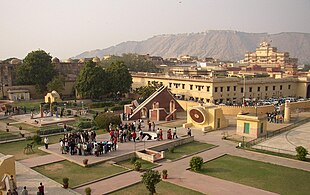Indian astronomy

The Indian Astronomy has a long history, ranging from the beginnings in the Indus Valley Civilization to this Indian space program.
Beginnings
The oldest roots of Indian astronomy lie in the stargazing of the Indus culture . Archaeological finds provide evidence that the Indus culture in Harappa may have used special round buildings for observing the sun and stars. The Vedas, the oldest religious writings in India, provide further evidence of the first astronomical activities on the Indian subcontinent. The descriptions of the calendar constellations in the Vedas date from around 2300 BC. BC, from the heyday of the Indus civilization.
The beginnings of Indian astronomy continued to develop as one of the Vedanga , one of the auxiliary disciplines of the Veda study. In the Vedas there are descriptions of the planets with their characteristic colors. According to these writings, the astronomical year comprises 360 days.
From the 4th century BC BC Indian astronomy was influenced by Greek astronomy. So were z. B. the writings Yavanajataka and Romaka Siddhanta Sanskrit translations of a Greek text that had been in circulation since the 2nd century. Images of the heavens and astronomical instruments, including sundials and the idea of a spherical earth, made their way to the Far East through Greek astronomy.
middle Ages
In the 5th to 6th centuries, Indian astronomy flourished with Aryabhata , whose script Aryabhatiya represented the top astronomical knowledge of the time. Among other things, it has already been recognized that the planets of the solar system move in elliptical instead of circular orbits. In addition, Aryabhata realized that the stars only appear to move around the earth. In fact, the impression that the stars are moving is created by the rotation of the earth around its axis. Aryabhata suggested that the moon does not shine by itself, but that the moon reflects the sunlight.
Indian astronomy decisively influenced Muslim astronomy, Chinese astronomy, and European astronomy. Important astronomers of the classical period who built on the work of Aryabhata were Brahmagupta , Varahamihira and Lalla .
In the 18th century, sky observation experienced a boom through the construction of the observatories that Jai Singh II had built in Delhi and Jaipur , among others . The largest of these, the Jantar Mantar in Jaipur, consists of fourteen structures for the observation and measurement of astronomical phenomena. It was added to the UNESCO World Heritage List in 2010 as a World Heritage Site .
A significant indigenous Indian astronomical tradition remained active through the Indian Middle Ages into the 16th or 17th centuries, particularly as part of the Kerala School of Astronomy and Mathematics. With the European influence from the 18th century, the native Indian astronomy was replaced by astronomy of European tradition.
Indian space travel
The Indian state has been involved in space travel since the 1970s, including satellite launches, sounding rockets and launch vehicles . Rakesh Sharma took part in the Soviet-Indian space flight Soyuz T-11 in April 1984, making it the first Indian cosmonaut in space. There are also projects to explore the planets of the solar system such as the Chandrayaan-1 lunar probe and the Mars Orbiter Mission .
See also
literature
KV Sarma: Astronomy in India . In: Helaine Selin: Encyclopaedia of the History of Science, Technology, and Medicine in Non-Western Cultures , 2nd edition. Springer, Berlin 2008, pp. 317–321, ISBN 978-1-4020-4559-2 .
Individual evidence
- ^ A b Syed Mohammad Ashfaq: Astronomy in the Indus Valley Civilization . In: Centaurus . 21, No. 2, 1977, pp. 149-193 .
- ↑ a b c d Nadja Podbregar: scinexx | The prehistory: India's astronomical tradition. Retrieved February 28, 2018 .
- ^ David Pingree: The Recovery of Early Greek Astronomy from India . In: Journal for the History of Astronomy . tape 7 , 1976, p. 109-123 .
- ↑ Nadja Podbregar: scinexx | An ambitious plan: Jai Singh and the stars. Retrieved February 28, 2018 .
- ↑ The Jantar Mantar, Jaipur. In: whc.unesco.org. UNESCO World Heritage Center, accessed March 2, 2018 .
- ^ The Space Review: India's space program looks outwards. Retrieved February 28, 2018 .